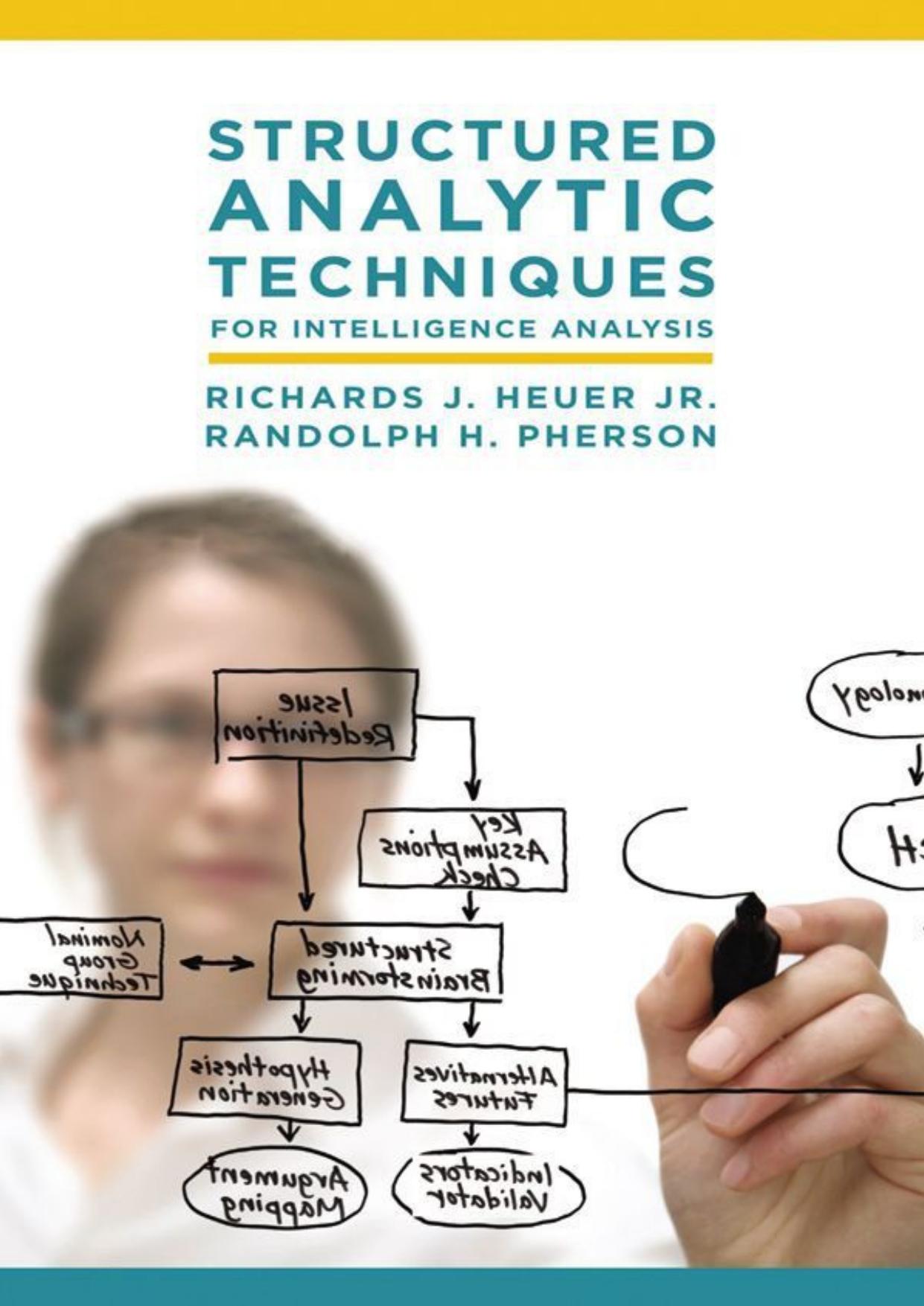Structured Analytic Techniques for Intelligence Techniques by Heuer Richards J. & Pherson Randolph H

Author:Heuer, Richards J. & Pherson, Randolph H. [Heuer, Richards J. & Pherson, Randolph H.]
Language: eng
Format: epub, pdf
Published: 0101-01-01T00:00:00+00:00
Overview of Techniques
Key Assumptions Check is one of the most important and frequently used techniques. Analytic judgment is always based on a combination of evidence and assumptions, or preconceptions, that influence how the evidence is interpreted. The Key Assumptions Check is a systematic effort to make explicit and question the assumptions (i.e., mental model) that guide an analyst’s thinking.
Structured Analogies applies analytic rigor to reasoning by analogy. This technique requires that the analyst systematically compares the issue of concern with multiple potential analogies before selecting the one for which the circumstances are most similar to the issue of concern. It seems natural to use analogies when making decisions or forecasts as, by definition, they contain information about what has happened in similar situations in the past. People often recognize patterns and then consciously take actions that were successful in a previous experience or avoid actions that previously were unsuccessful. However, analysts need to avoid the strong tendency to fasten onto the first analogy that comes to mind and supports their prior view about an issue.
Role Playing, as described here, starts with the current situation, perhaps with a real or hypothetical new development that has just happened and to which the players must react. This type of Role Playing, unlike much military gaming, can often be completed in one or two days with little advance preparation. Even simple Role Playing like this will stimulate creative and systematic thinking about how a current complex situation might play out. A Role Playing game is also an effective mechanism for bringing together analysts who, although they work on a common problem, may have little opportunity to meet and discuss their perspectives on that problem.
Red Hat Analysis is a useful technique for trying to perceive threats and opportunities as others see them. Intelligence analysts frequently endeavor to forecast the behavior of a foreign leader, group, organization, or country. In doing so, they need to avoid the common error of mirror imaging, the natural tendency to assume that others think and perceive the world in the same way we do. Red Hat Analysis is of limited value without significant cultural understanding of the country and people involved. See chapter 9 for a discussion of how this technique differs from Red Team Analysis.
Outside-In Thinking broadens an analyst’s thinking about the forces that can influence a particular issue of concern. This technique requires the analyst to reach beyond his or her specialty area to consider broader social, organizational, economic, environmental, technological, political, and global forces or trends that can affect the topic being analyzed.
Policy Outcomes Forecasting Model is a theory-based procedure for estimating the potential for political change. Formal models play a limited role in political/strategic analysis, since analysts generally are concerned with what they perceive to be unique events, rather than with any need to search for general patterns in events. Conceptual models that tell an analyst how to think about a problem and help the analyst through that thought process can be useful for frequently recurring issues, such as forecasting policy outcomes or analysis of political instability.
Download
Structured Analytic Techniques for Intelligence Techniques by Heuer Richards J. & Pherson Randolph H.pdf
This site does not store any files on its server. We only index and link to content provided by other sites. Please contact the content providers to delete copyright contents if any and email us, we'll remove relevant links or contents immediately.
Periodization Training for Sports by Tudor Bompa(8144)
The Body: A Guide for Occupants by Bill Bryson(4950)
The MacArthur Bible Commentary by John MacArthur(4731)
The Sports Rules Book by Human Kinetics(4268)
What It Really Takes to Get Into Ivy League and Other Highly Selective Colleges by Hughes Chuck(3676)
Marijuana Grower's Handbook by Ed Rosenthal(3605)
The Sprouting Book by Ann Wigmore(3529)
The Martian by Andy Weir(3285)
Salt, Fat, Acid, Heat: Mastering the Elements of Good Cooking by Nosrat Samin(3094)
The Bread Bible by Rose Levy Beranbaum(2987)
Harry Potter 4 - Harry Potter and The Goblet of Fire by J.K.Rowling(2971)
Sapiens and Homo Deus by Yuval Noah Harari(2967)
The Marketing Plan Handbook: Develop Big-Picture Marketing Plans for Pennies on the Dollar by Robert W. Bly(2950)
Classic by Mary Berry(2929)
Martha Stewart's Baking Handbook by Martha Stewart(2783)
Screenplay: The Foundations of Screenwriting by Syd Field(2559)
The Plant Paradox by Dr. Steven R. Gundry M.D(2526)
50 Economics Classics by Tom Butler-Bowdon(2509)
The Cambridge Grammar Of The English Language by Rodney Huddleston Geoffrey K. Pullum(2368)
